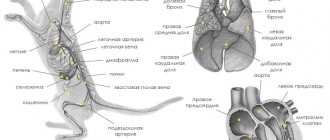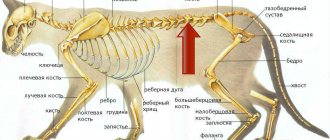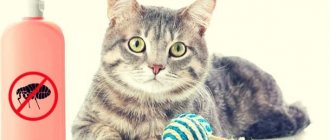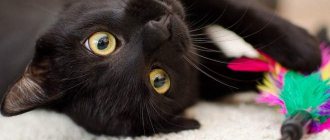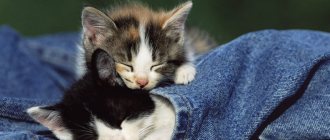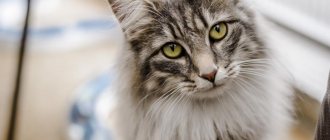The domestic cat is a mammal that belongs to the order Carnivora and the cat family. Cats are also social animals; they hunt small rodents alone. To communicate, the domestic cat uses a variety of wide-range sound signals, as well as a variety of body movements and specific odors (pheromones). To date, approximately 200 breeds have been bred and are registered felinologists. Today, the domestic cat is a subspecies of the forest cat, but this was not always the case. Previously, the domestic cat was a separate biological species. Cats have often saved humanity from hunger and diseases caused by rodents. After all, they have been side by side with us for 10 thousand years.
Features of sexual hunting
From 8 months the cat is considered sexually mature. If the male does not live in a closed room (apartment) and has free access to the street, during this period he begins to disappear from the house for a long time in search of a sexual object. The owners will immediately understand that their pet has grown up - during the onset of puberty, he begins to meow frequently at night.
The behavior and character of the cat changes, it may become more aggressive. Sexual activity among representatives of the cat world is well expressed. If a pet does not have access to the street, it can imitate sexual intercourse using soft toys and wool clothing. Every time the cat will react violently if a sexually mature female is next to him. If a pet lives in a private home, the owners need to try very hard to keep it from escaping.
For the first sexual intercourse, a sexually mature cat will always choose an experienced female who has already given birth.
If mating occurs in a cat without sexual experience, the owners of the animals should bring them to mating no more than once a month. When they become more experienced and learn to behave appropriately, mating can be carried out 2 times a week.
Causes for concern
Sometimes owners sound the alarm when a cat, after mating, begins to behave as if she is sick. This is often accompanied by diarrhea or vomiting, and sometimes the temperature rises. There are several explanations for this:
- pronounced reaction to stress (presence of a male or moving, change in hormonal levels, etc.);
- digestive disorders due to a change in diet, if the animal was given to another home for mating without the usual food;
- the onset of toxic infection is possible, which is not associated with attempts to have offspring;
- bacterial or viral infection for which the male has not been vaccinated (calcivirosis, rhinotracheitis, panleukopenia, etc.).
How does a cat behave during its first sexual experience?
If cats mature for procreation at the age of 8 months, and their sexual maturity is pronounced, then in cats everything is a little different. They mature by 9 months and, unlike cats, do not show aggression, but, on the contrary, become overly gentle towards their owners.
A cat that has started walking is strikingly different in its manners - it will walk in circles around the male, fawn over him, and its poses will be quite specific. A cat may mark its territory in the house with urine.
Sexual activity among representatives of the cat world varies and depends on the breed. Cats living at home have a shorter period of sexual activity than indoor cats. The estrus period also depends on the time of year. In winter it lasts no more than 5 days, in summer – several weeks.
During the first intercourse, the cat will behave passively. Some individuals may not allow the cat to approach them at all for the first time, showing increased aggression. Mostly Sphynx and Scottish cats behave this way. The possibility of childbearing remains in females up to 8 years.
Why does a cat still “flow” after mating?
In fact, everything is natural and natural. Usually, for several hours and even days after coitus, the female will behave restlessly, still purring, rolling on the floor and lifting her tail when any touch to the rump.
The phenomenon is explained simply: during estrus, a huge amount of sex hormones are released into the blood, and it takes some time for the body to adjust to its normal mode. Ovulation occurs somewhere 24-36 hours after intercourse, it is quite logical that the animal will still be in heat for at least a day and then it will take another 2-3 days for all the accompanying symptoms to subside.
In such cases, they focus on the cat’s behavior. If he has lost all interest in the imported bride, then ovulation has occurred and the expectant mother can safely be taken home.
Sometimes, even after successful fertilization, the female experiences repeated estrus (superfetation) and again asks for a cat. The phenomenon is associated with decreased progesterone levels during the current pregnancy. Under no circumstances should repeated mating be allowed, especially if 2 months (65-70 days) have not yet passed since the previous one, otherwise there will be two batches of embryos of different ages in the uterus at once. There are two possible developments:
- timely birth, while the younger litter dies;
- the cat first gives birth to the first litter, and a few weeks later the second.
Behavior of a cat during estrus
Unlike dogs, in which estrus is signaled by bloody vaginal discharge, cats do not have this symptom. But the behavior of cats changes so dramatically and becomes specific that the owner can easily determine that the pet has entered the active sexual phase:
- Becomes more affectionate, following on the heels of the owner. If the owner is a man, he begs for attention and tenderness from him.
- Spends most of its time in motion, rubbing against furniture and the legs of its owners.
- Takes a specific pose - raises its tail, leans on its hind legs, lifting its pelvis up as much as possible. In this position he can move around the room, backing away.
- Either he stops eating anything altogether, or his appetite decreases significantly.
- He asks to use the litter box more often, as the urge to urinate becomes more frequent.
- It meows more and more often, gradually the usual meowing is replaced by extremely unpleasant, heart-rending screams, which are very difficult for the owners to endure.
Estrus lasts for 5-6 days and repeats every 15-20 days. The presence of the above-described signs is the standard course of estrus in cats, but it also happens that the stage of sexual activity occurs without pronounced signs, this is the so-called latent estrus. The owners will only be glad that their pet lacks open sexual activity, but for breeders this feature of the female can be a real problem.
First contact requirements
A partner for a meowing ward is found in advance. They look through advertisements, go to exhibitions, prepare their pet for the decisive meeting.
Rules for mating cats:
- To avoid dangerous pathologies, estrus cannot be stopped with hormonal or other drugs.
- The first mating of cats requires a fully completed vaccination plan (4 weeks must pass after the last immunization).
- Half a month before intercourse, deworming is carried out.
- On the day of the meeting, the “bride” (as well as the “groom”) have their claws trimmed to avoid injury.
- It is wrong to bathe cats before mating: soap and shampoos muffle the smell of pheromones.
- At the crucial hour, they make sure that the female is moderately well-fed, well-groomed, with clean ears, clear eyes, and a shiny nose.
Mating a cat and its conditions:
- The breeder is supposed to be healthy, vaccinated, treated for worms, and externally well-groomed.
- To stimulate sexual activity, it is recommended to enrich the menu with B vitamins a couple of days before intimacy.
- The cat owner, as the owner of the “mating station”, is obliged to ensure that the meeting is successful: organize an acquaintance, competently stimulate the development of sexual relations, and be responsible for the comfort and safety of the furry guest.
The meeting of a pair of virgins is undesirable. It is fraught with psychological or physical damage.
Mating cats - features and stages
It is impossible to predict in advance how the first acquaintance between a female and a male will go. Animals may immediately like each other, or they may show unmotivated aggression.
In order for pets to become friends faster, mating should be carried out in a separate, closed room.
Moreover, in a prepared area there is a greater chance that they will find a common language.
First, a container with a cat is brought into the room; she needs to be left alone for some time so that she becomes familiar with the new conditions. Only after the cat has studied everything and calmed down can the male be brought into the room. An indicator that mating will take place with the expected result is normal, typical behavior of animals. If a cat immediately began to show aggression towards each other, it is unlikely that their acquaintance will lead to anything.
If the cat likes the male, a short period of flirting begins. The animals exchange greetings, after which the cat, after petting the cat several times, allows him to come closer to her. If the female does not like the partner chosen by the owners, she will begin to behave aggressively: she will hiss and growl, and may even bite a cat who tries to come closer to her. Owners must monitor how animals behave. If aggressive behavior occurs, pets should be immediately separated and isolated.
Act of intimacy
As soon as the seals have gotten used to each other, got acquainted and exchanged greetings, after a short sexual foreplay, the female allows the male to approach her, making it clear that she is ready for sexual intercourse by standing in a specific position - with an emphasis on her hind legs, raising her pelvis and tail high . The cat approaches the female from behind, digs her teeth into her nape, and hugs her from the sides with her front paws.
The actual process of intercourse lasts very quickly, with instant ejaculation. At the same time, the cat will purr, and the female will scream heart-rendingly (this scream has its own good reasons). After sexual intercourse, the cats separate in a rather specific manner - the cat with a sharp movement jumps away from the female, who in turn hits him with her paw.
After sexual intercourse, the cat’s behavior changes dramatically – it behaves specifically and aggressively. Aggression is explained by the fact that the cat’s penis is rough, and the female experiences unpleasant, painful sensations during intercourse due to the fact that the vaginal mucosa is highly irritated.
Severe pain during sexual intercourse in a cat is also caused by the fact that the scales on the penis dig into the uterus, which is why the cat screams heart-rendingly after the act. But this irritation is necessary in order to stimulate ovulation in the cat, which begins within 24 hours after mating.
If a cat mates for the first time, there is a high chance that ovulation will not occur immediately. After the first sexual intercourse, several more intercourses must occur for the cat to become pregnant, so the animal must be left with the male for several days. Animals can experience up to 10 acts per day.
The owner should not be far from his pets during the mating period. As a result of the rather aggressive and specific behavior of the female, unforeseen situations may arise, so the presence of a person is necessary to come to the rescue in time.
What to do if mating is not in your plans
Unsatisfied sexual instinct leads to many negative consequences.
Untied animals have hormonal imbalances, they yell, lose weight, and cats mark their territory. The risk of cancer, pathologies of internal organs and the cardiovascular system increases.
If you do not plan to breed purebred kittens, and a career as a breeder is not part of your plans, it is best to take care of spaying your cat and neutering your cat.
Rules for choosing a partner and preparing animals
The choice of a female for a male must be approached with great responsibility, since the quality and quantity of kittens, genetic features, and the successful outcome of the mating itself will depend on the correct choice of partners. If the cat has already had sexual experience, it is worth looking at what the offspring from his previous matings were like.
The best choice would be a prepotent animal, since such a partner will be able to pass on the best genetic set to the kittens. To achieve the best litter from mating a cat with a cat, it is recommended to consult a specialist when choosing a partner.
Before mating, animals need to trim their claws so that they do not injure each other. It is not recommended to perform hygiene procedures on pets, much less bathe them using scented hygiene products. Individuals should exude a natural scent, this increases the likelihood that they will be able to make friends, and the mating will take place with the desired result.
It is recommended to carry out mating in the territory of the male.
In order for the female to feel comfortable in new conditions, you need to bring her litter tray, bowls for food and water, as well as food if it becomes known that the cat eats a different type of industrial diet.
The container with the cat is placed in the middle of the room and left with the door open. Forcibly pulling a cat out of such a shelter is strictly prohibited. The female must calm down on her own and begin exploring the territory. If you force a cat out, it may become very frightened and then refuse to leave the container at all.
When mating purebred cats, you need to take into account a number of nuances. So, for example, a fold-eared cat can only happen to a cat whose ears are straight, otherwise genetic abnormalities cannot be avoided in the resulting litter.
Solving problem situations
In the affairs of amorous animals, not everything goes smoothly. In some cases, a couple needs help from:
- The cat hisses at the cat when mating. There is no need to rush animals, especially inexperienced ones. They need more time for foreplay.
- The cat is smaller in size than its partner, as a result of which the cat rests on its back. In this case, it is necessary to send the male.
- The bride falls on her side during sexual intercourse. In such a situation, they support the female.
We suggest you read: What to feed a castrated cat with natural food. Feeding a cat after castration: features of natural and industrial nutrition
Breeding cats outdoors
A barn cat, when she begins her period of heat and is ready to mate, secretes a special hormonal secretion, and it is its smell that attracts many males. They find the female, surround her and begin to fight for primacy, engaging in battle with each other. A barn cat has a large choice and chooses the male she likes the most. But, as a rule, the cat that won the fight with other male contenders will participate in mating.
The tactics of a cat are interesting, who at all costs wants to emerge victorious from the battle - by entering into skirmishes with other males, with each victory he becomes closer to his goal. But as soon as the cat glances at him, he feigns complete indifference. When a male conquers a female, he approaches her as close as possible and begins to scream heart-rendingly in her ear. If there was no negative reaction from the cat, she did not run away, but continued to lie in the appropriate position, sexual intercourse begins.
After mating, the cat vomits, diarrhea, does she have a fever?
Such symptoms, although quite rare, do occur. Why is this happening?
- Consequences of stress: change of environment, rampant hormones, etc.
- Stomach upset as a result of a sudden change in food, if the owners of the female for some reason forgot to transfer the usual food to the temporary place of residence.
- Food poisoning, poisoning, which are in no way related to cages, but are a coincidence of two phenomena in time.
Very rarely, if cat owners are negligent about vaccination, a cat can pick up a pathogenic virus in someone else’s home. There have been cases when, after mating, a female became infected with calcivirosis, rhinotracheitis, panleukopenia, rhintotracheitis, etc.
That is why it is so important to check the breeder’s veterinary passport before mating and inquire about the vaccinations given. Even a healthy-looking cat, which is full of strength and energy, can turn out to be an “incubator” (a carrier of the virus) and transmit a terrible and dangerous disease to its lover. By the way, cat owners should also not forget about preventive vaccination.
We deliver babies
- Interesting facts about cats
- Cute dog breeds
- The richest animals
- Cat claw attachments
- Dog
- Long-eared cats
There are three stages of childbirth. The developing fetuses, protected by the amniotic membrane, are attached to the wall of the uterus by the placenta, and are located in the horns of the uterus, which in a cat is bicornuate. The horns, at the point of their connection, pass into the uterine canal, which passes through the cervix into the vagina, and it, through the vestibule of the vagina, into the vulva. All these structures together are the cat’s birth canal. During the course of labor, three periods can be roughly distinguished. In the first period, the cervix dilates and the birth canal opens, in the second, kittens are born, and in the third, the placenta comes out.
The first stage of labor can last from 12 to 24 hours and in the initial stage it can be almost unnoticeable. And it all begins with chaotic, voluntary contractions of the uterus (pushing), during which the cat’s breathing quickens and she purrs to the beat. These contractions are at first rare and weak, looking like peristaltic waves from the top of the uterine horn to its body. The uterine horns contract alternately, gradually pushing the fetuses into the uterus.
The vagina swells a little a few hours before contractions, and a thick sticky discharge of a transparent, yellowish or bloody color appears from it. At this time, the cat becomes restless, licks the vulva (loop), strains as if during defecation, meows pitifully, and rakes up the bedding.
As the labor process progresses, contractions become more frequent and their duration increases, while the pain intensifies. During contractions (i.e. contractions of the uterus), the fetus is pushed further towards the cervix, and it dilates. And when the abdominal muscles begin to contract and the fetus moves into the vagina, the birth process is in full swing. At this time, a cat giving birth for the first time can be extremely frightened, and then she screams pitifully and seeks help from the owner, who must constantly reassure her by talking to her and caressing her.
During contractions, intrauterine pressure increases and the vascular membrane (chorion) ruptures. The amnion (water membrane) and allantois (urinary membrane), filled with fluid, are introduced into the cervix, expanding its canal like a hydraulic wedge. From this moment on, the cervix, uterus and vagina form one wide birth canal. During the formation of the birth canal, the presentation and articulation of the fetus is established for its exit from the uterine horn.
Gradually, pushing joins the contractions. They are caused reflexively, as a result of irritation of the nervous elements in the tissues of the cervix and pelvic walls by the presenting parts of the fetus. If you put your hand on the female's belly while pushing, you can feel it hardening. The pain continues to intensify, causing the cat to meow more and more pitifully and breathe frequently (like dogs in the heat). In between attempts she relaxes. Under the influence of contractions, supported by pushing, the fetus passes deeper and deeper through the birth canal. Gradually moving forward, the kitten comes out into the pelvis, and then is forcefully pushed further towards the exit from the vagina, passing part of the way with a strong contraction.
Second stage of labor
Usually on this section of the path the strength of the contractions is greatest. The water sac (amnion) surrounding the fetus appears between the labia of the vulva, ruptures, and a straw-colored fluid flows out. This is the release of amniotic fluid. Amniotic fluid lubricates the passage, facilitating the advancement of the fetus. Finally, part of the kitten (paw, head, tail) appears from the loop, appearing and then disappearing again.
As a rule, at this moment the cat relaxes and rests to gather strength. In classic cases, the cat makes two strong attempts at once and expels the kitten, connected by the umbilical cord to the afterbirth. The kitten is born with or without the membrane. About 70% of kittens are born in the "diver" position - with their forelimbs and nose first. The cat independently processes the baby, gnawing the membranes (if any), intensively licking the kitten's face, cleaning its nose, mouth and body, thereby stimulating its breathing and blood circulation, causes the first separation of feces, after which it gnaws the umbilical cord. The kitten takes a sharp breath, its lungs expand, and it begins to breathe.
Maternal instinct is a very important connection. The cat understands that this is her “baby” and she is obliged to take care of him. Sometimes from the outside it seems that she does everything rudely, but in fact she stimulates the cub’s breathing and blood circulation. The cat rests for some time after the birth of a kitten, then contractions and pushing resume, and the next kittens are born. Most cats kitten at intervals of 15 minutes to an hour. Two or three kittens may be born one after the other, but the next ones can be expected within another 3-4 hours, and sometimes longer. If a cat who is handling another kitten forgets to remove the amniotic sac, you must do it for her very quickly, otherwise the kitten will suffocate.
Third stage of labor
The separation of the placenta (baby place) is noted, which comes out a few minutes after the birth of each kitten. The mother will try to eat some or all of the placentas. This is a purely instinctive reaction, which may have been preserved from those ancient times when the animal had to strengthen its strength and destroy all traces of childbirth in order to save its offspring. However, she may not do this. Eating afterbirth leads to a laxative effect, that is, diarrhea. You can limit the amount of afterbirth she eats or let her eat them all.
Cats chew the umbilical cord, grinding it (in this case, the blood vessels are twisted and overstretched, and bleeding does not occur). If it is crossed too smoothly or too close to the navel, bleeding occurs. The umbilical cord should be compressed, tied with thread and cauterized with iodine or some other suitable antiseptic. It is important not to tighten the umbilical cord too much, so as not to provoke a hernia. Once some or all of the kittens have been born, the cat lies on her side and pushes them towards her nipples. Sucking kittens stimulates uterine contractions and the secretion of colostrum (mother's first milk), which contains all the necessary maternal antibodies.
Sometimes childbirth seems to stop, the Cat calms down and takes care of the kittens. Then, after 12-24 hours, labor resumes and the cat gives birth to the rest of her kittens. This is absolutely normal and there is no need to worry unnecessarily. There are no identical births; all cases are individual. It is quite difficult for a breeder with no experience to determine the boundary between the norm and the anomaly. It happens that a cat that has given birth to 3-4 litters without any problems suddenly develops complications during subsequent births and has to undergo a caesarean section. And vice versa.
First meeting
Once on someone else's territory, the groom will try to mark it, or he may become embarrassed and not show the proper ardor during mating, which is why the bride is usually brought to the cat.
For the cat, they take with them a “dowry” - its tray, bowl and familiar carrier, where it can hide and rest if necessary.
Of course, the bride should be well-groomed, but there is no need to bathe her before the meeting, this will take away the natural smell that attracts mating. The groom's owners are responsible for the safety of the bride and provide a place for marriage games.
